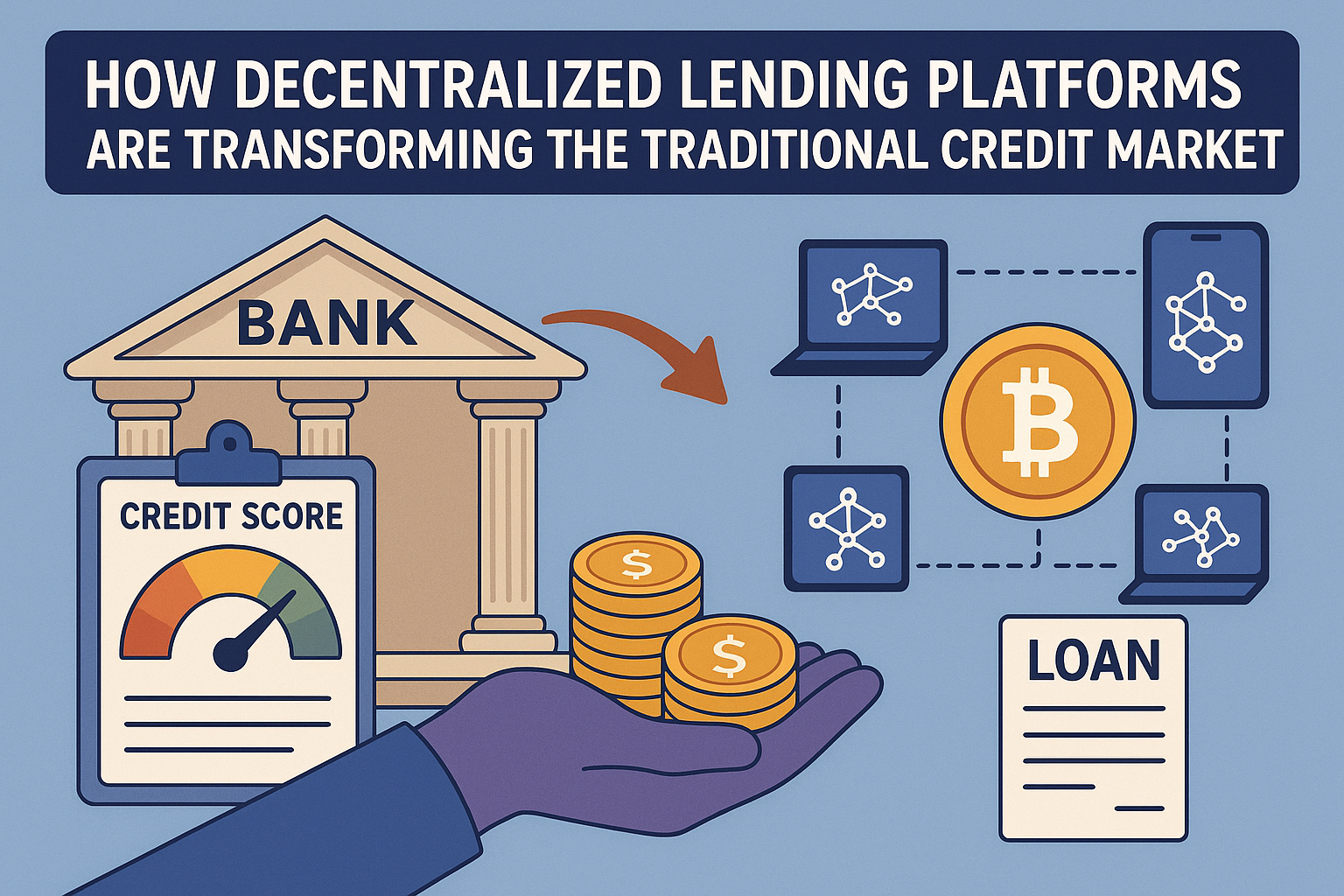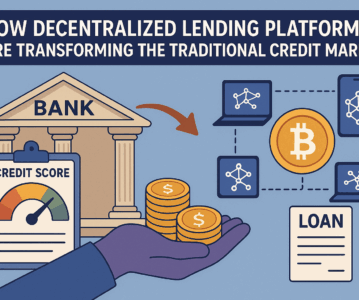
In the wave of financial technology innovation, decentralized lending platforms, commonly referred to as DeFi (Decentralized Finance) lending platforms, are reshaping the global financial landscape with a disruptive approach. Unlike traditional credit markets that rely on centralized intermediaries such as banks and credit rating agencies, DeFi lending platforms leverage blockchain technology and smart contracts to offer intermediary-free, transparent, and efficient lending solutions. According to DeFi Pulse, as of July 2025, the total value locked (TVL) in DeFi protocols has surpassed $100 billion, with lending platforms holding a significant share. This emerging model not only lowers entry barriers and enhances flexibility for users but also challenges the efficiency, cost, and accessibility of traditional credit markets.
The rise of DeFi lending platforms stems from the maturation of blockchain technology, particularly the smart contract capabilities of platforms like Ethereum. From the initial emergence of DeFi protocols in 2017 to the current diverse ecosystem encompassing lending, derivatives, and payments, DeFi has become a pivotal force in fintech innovation. This article delves into the mechanics and evolution of decentralized lending platforms, compares them with traditional credit markets, explores their advantages and challenges, analyzes real-world cases, and evaluates their impact and future trends in transforming the traditional credit landscape.
Decentralized lending platforms operate on blockchain technology, utilizing smart contracts to create an intermediary-free lending ecosystem. The core mechanism involves users depositing funds into liquidity pools, where smart contracts automatically match lending and borrowing demands while determining interest rates and collateral requirements based on algorithms. Users interact with these platforms directly via crypto wallets, ensuring transparent and immutable transaction records on the blockchain. For instance, platforms like Aave and Compound dynamically adjust interest rates to balance supply and demand, ensuring market efficiency.
The evolution of DeFi lending began with the launch of MakerDAO on Ethereum in 2017, a pioneering protocol for decentralized lending. According to DeFi Pulse, MakerDAO’s DAI stablecoin and lending protocol saw its TVL exceed $2 billion by 2020. Recent years have witnessed significant advancements, such as Layer 2 solutions reducing transaction costs and cross-chain technologies enhancing platform interoperability. By 2024, global DeFi users surpassed 10 million, reflecting the sector’s rapid growth and its potential to redefine financial services.
Traditional credit markets revolve around centralized institutions like banks and credit unions, relying on credit assessments, collateral reviews, and manual contract execution. This model often incurs high operational costs and lengthy approval processes. In China, for example, small and medium-sized enterprises (SMEs) typically face loan approval timelines of 2-4 weeks, with many unable to secure financing due to insufficient credit history. Additionally, traditional markets are constrained by geographic and regulatory barriers, making cross-border lending costly and limited in scope.
In contrast, decentralized lending platforms enable globalized fund flows and instant transactions via blockchain. For example, Compound allows users to complete lending or borrowing in minutes without extensive identity verification or credit scoring. DeFi platforms determine interest rates based on market dynamics rather than institutional policies, often resulting in more competitive rates. However, traditional markets offer mature regulatory frameworks and consumer protections, while DeFi platforms face challenges related to regulatory uncertainty and technical risks.
The primary advantage of DeFi lending platforms lies in their efficiency and cost-effectiveness. Traditional banking processes, involving manual reviews and legal contracts, incur high operational costs, whereas DeFi platforms automate these functions via smart contracts, significantly reducing fees. For instance, Aave’s lending fees are typically below 0.5%, compared to 2%-5% for traditional bank loan management fees. Moreover, DeFi’s open access allows global participation, bypassing geographic or identity restrictions, which is particularly valuable for small businesses in developing regions.
Another key benefit is transparency and traceability. All transactions are recorded on public blockchains, enabling users to monitor fund flows and rate changes in real time. MakerDAO’s DAI lending protocol, for example, publicly discloses collateralization ratios and liquidation mechanisms, fostering user trust. Additionally, DeFi platforms mitigate default risks through over-collateralization, requiring borrowers to provide 150%-200% of the loan value in crypto assets, ensuring lender security.
Despite their advantages, DeFi lending platforms face significant challenges. Technical risks, such as smart contract vulnerabilities, pose a major threat. For instance, the 2021 Poly Network hack resulted in $600 million in stolen assets due to a code exploit. Network congestion and high gas fees on blockchains like Ethereum have also hindered accessibility, though Layer 2 solutions are alleviating this issue. These technical limitations underscore the need for robust security measures and scalable infrastructure.
Regulatory uncertainty is another critical hurdle. DeFi’s borderless nature complicates compliance with traditional financial regulations. In 2024, the U.S. Securities and Exchange Commission (SEC) initiated lawsuits against several DeFi platforms, demanding adherence to securities laws, raising concerns about stricter oversight. Additionally, the anonymity of DeFi platforms may facilitate illicit activities like money laundering, increasing compliance risks. User education gaps and market volatility further expose retail investors to potential losses.
Aave, a leading Ethereum-based DeFi lending protocol, exemplifies the sector’s potential. With over $20 billion in TVL as of 2025, Aave’s innovative “flash loans” allow users to borrow without collateral, provided repayment occurs within the same blockchain transaction. This feature supports arbitrage traders and developers but has sparked concerns about market manipulation risks. Aave’s success highlights the flexibility of DeFi but also underscores the need for careful risk management.
MakerDAO, another prominent case, uses its DAI stablecoin, pegged to the U.S. dollar via over-collateralization, to provide stable lending assets. In 2023, MakerDAO’s governance token holders voted to adjust collateral ratios and interest rates, showcasing decentralized governance. However, during the March 2020 market crash, MakerDAO faced liquidation failures due to price volatility, revealing vulnerabilities in extreme conditions. These cases illustrate DeFi’s innovative potential alongside its operational challenges.
DeFi lending platforms are disrupting traditional credit markets by enhancing efficiency and intensifying competition. Their automation and low-cost models pressure banks to accelerate digital transformation. For instance, since 2023, the Industrial and Commercial Bank of China has introduced blockchain-based supply chain financing to counter DeFi’s appeal to SMEs. DeFi’s global reach and inclusive nature also expand financial access, particularly in developing nations, where unbanked populations gain lending opportunities.
However, DeFi’s rise poses challenges. Traditional institutions benefit from robust compliance and consumer protections, areas where DeFi lags. A 2024 Bank for International Settlements (BIS) report warned that DeFi’s growth could threaten financial stability during market volatility. This has spurred exploration of hybrid models, with traditional institutions integrating DeFi via APIs to combine efficiency with regulatory compliance, fostering a collaborative financial ecosystem.
Looking ahead, DeFi lending platforms will evolve through technological innovation and regulatory adaptation. Cross-chain technologies like Polkadot and Cosmos will enhance interoperability, with the cross-chain lending market projected to reach $50 billion by 2026. Layer 2 solutions will further reduce costs, while AI and big data integration will optimize risk management, such as predicting market fluctuations to adjust collateral ratios dynamically.
Regulatory developments will shape DeFi’s trajectory. In 2025, global jurisdictions are crafting DeFi-specific frameworks, such as the EU’s Markets in Crypto-Assets (MiCA) regulation, set for full implementation by 2026. These frameworks will provide clarity while potentially restricting high-risk features. The convergence of DeFi and traditional finance, or “CeDeFi,” will likely accelerate, offering users hybrid solutions that balance efficiency and security.
Decentralized lending platforms are revolutionizing traditional credit markets by leveraging blockchain and smart contracts to deliver efficient, low-cost, and inclusive financial services. Their global accessibility and transparency challenge the inefficiencies of centralized systems, particularly for underserved populations. However, technical vulnerabilities, regulatory uncertainties, and market risks necessitate robust risk management and user education. Case studies like Aave and MakerDAO highlight DeFi’s potential and pitfalls, emphasizing the need for balanced innovation.
In the future, technological advancements and clearer regulations will drive DeFi’s integration into the broader financial system, fostering competition and collaboration with traditional institutions. Fintech professionals should monitor DeFi’s evolution, capitalize on its opportunities, and address its risks. Decentralized lending platforms are not merely a complement to traditional credit markets but a transformative force poised to redefine the future of finance.
